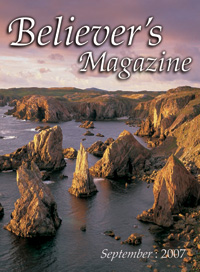THE FLOOD AND ITS EFFECTS
The worldwide flood described in Genesis 6-8 must be fully taken into account in any attempt to understand and interpret the past and present history of the earth. When we think about the flood, for good reasons we tend to focus on the spiritual side of it, its cause and effects, and the beautiful picture of salvation from judgment in the ark which God provided. But in Scripture there are some hints as to physical effects it had upon the face of the earth, to which geology bears witness very clearly. The world was a very different place after the flood from what it was before it. Indeed that is what 2 Peter 3.6-7 tells us, as we have noted before.
The flood was an immense cataclysm of dimensions which we can hardly imagine, a dramatic change to conditions which prevailed in the earth up till then. Creative processes ended with the words of Genesis 2.1-3, God’s creation was very good. But sin entered, deterioration began and brought with it those processes which continue until now, which steadily and inevitably lead to decay and death. These are the processes to which apply the natural laws we have considered before. Then, for well-known reasons which He explained before it came, God in His sovereign power superimposed on top of these this great flood using materials and forces already present and latent in the earth and its surroundings since the days of creation. It had never happened before, and it will not happen again, witness God’s promise of this every time you see the pure beauty of a rainbow (Gen 9.12-16)!
Changes
The changes made by the flood were numerous and far reaching. The world would not be the same again. These changes affected mankind and subsequent generations, the type of environment in which they would now live, and the physical structure of the surface of the earth which would only be explored in detail and in depth thousands of years later.
As for mankind, after the flood the human race split into three branches which are recognisable to this day throughout the world. Whilst the Bible does trace us all back to Adam for the original sin which has passed upon all, ethnically each of us has a family tree which stretches back to one of the sons of Noah. Modern genetic marker studies have confirmed this. From Shem came Abraham and the Jewish and Arab nations; from Japheth came the broad sweep of Gentile nations spread to the farther reaches of the earth by land and sea; from Ham, came those nations which found their home in the African continent. But now to them all, the gospel of the grace of God has gone without distinction and without favour - "whosoever will may come". This is seen even in the earliest spread of the gospel, when in Acts 8 a seeking son of Ham hears of the Saviour in the desert of Gaza and obtains grace, in ch.9 a hardened and rebellious son of Shem receives mercy on the road to Damascus, and in ch.10 a devout son of Japheth finds peace through Jesus Christ, who is Lord of all (v.36).
Another change affecting man was the length of his life. Before the flood many hundreds of years was a normal lifetime, according to Genesis 5, but for those born after the flood this life span steadily decreased to around one or two hundred years (see Gen 11.10-26), until from the end of Genesis and into the rest of the Old Testament, few people lived beyond 100. "Threescore years and ten", or "fourscore" (Ps 90.10) soon became the norm, as it still is worldwide. A possible reason for all this we shall look at shortly.
Climate Contrasts
When the flood came, a truly vast amount of water fell from the skies on to the earth for forty days and nights without interruption, in addition to the upwelling of waters from beneath the earth’s surface. Both of these were totally unprecedented phenomena, released by God for His "strange work" of judgment (Is 28.21), for He delights in mercy. The waters which God had put "above the firmament" on creation day two for protection were now used for destruction as they deluged and inundated the earth.
It appears that rainfall as such was unknown before the flood, plant growth and other water needs being provided for by a cyclical "mist" which rose from the earth’s surface by solar heating and returned, possibly nightly (see Gen 2.5-6). Furthermore, that large amount of water which was above the aerial atmosphere ("firmament") would be in vapour form, surrounding the globe in considerable thickness. This water vapour blanket or layer would have an important effect on the earth’s climate and the well-being of every one of its inhabitants. Firstly, it would give a "greenhouse effect" and prevent extremes of heat and cold on the earth, so that a uniformly temperate or subtropical climate could have been present all over the world, giving conditions for luxuriant growth of vegetation and survival of animals and of course man. Secondly, it would filter out most of the harmful cosmic rays which bombard planet earth continuously, and also much of the harmful ultraviolet radiation, shielding everything from these particles and rays which are known to cause damage to living tissue and produce disease and ageing.
So, in antediluvian times, although the peace and beauty of Eden itself had gone, climate conditions were benign, ideal for life and growth. It is little wonder therefore that people lived so long and had large families throughout their lives. In addition, animal and plant life could thrive, so that huge animals, eg. mammoths and dinosaurs in all their variety, could exist all over the world, and huge forests, grasslands, and swamps of immense variety and density would be normal, with huge specimens in them. Later, when buried and compacted during the flood, all this vegetation would provide the world’s enormous coal beds, and, by a different mechanism involving different organisms, vast oil fields also. We will consider fossils in some detail later, but you can readily see how all this fits together.
After the flood it was all so different across the globe. Without the shielding of the high altitude water vapour canopy, extremes of temperature and contrasting seasons would become common (see Gen 8.22, the first references in the Bible to summer and winter, cold and heat). With the drying up of the flood, mighty winds blew (8.1), surface waters would freeze, ice sheets would form and make their marks on the landscape as they moved and melted. Mankind would face a new set of difficulties which would have far reaching effects, and many plant and animal species which had been common before could exist no longer, unable to adapt to the changed environment, except for a few which found a niche in which to survive. This is when "survival of the fittest" would really apply, and is mainly why dinosaurs and similar land giants would become extinct.
Radiocarbon Dating
How long ago all this happened is not certain, although the records of Scripture do suggest it was somewhere around 3000 BC. However, there is a method called radiocarbon dating which has given dates for certain artefacts a lot earlier than this, even back to around 10,000 BC. It works like this.
When, for example, a growing tree absorbs carbon dioxide from the atmosphere, in it there is a small amount of a radioactive form of carbon called carbon 14, which steadily decays (reduces in amount) after the wood is cut down. By measuring the small amount of carbon 14 which is in a specimen at present, and comparing this with what was there when the wood was growing, the age of the specimen can be calculated because the rate of decay is known (the "half-life" is 5730 years). The key assumption in the calculation is that the amount of carbon 14 absorbed into the wood while it was growing long ago is the same as it is today.
Now this is highly unlikely, because carbon 14 is produced in the upper atmosphere by the bombardment of nitrogen atoms by cosmic rays which fluctuate over even centuries of time. But if we go back to pre-flood conditions, the vapour canopy would filter out most of these cosmic rays. Thus much less carbon 14 would be produced to enter the growing wood, and therefore proportionately much less would be left in the specimen now. Hence, if dated by this method, all samples from the era of the flood will appear to be much older than in fact they are. Thus radiocarbon dates older than about 5,000 years are in doubt, and many authorities recognise this. We recognise the reliability of the Biblical records.
To be continued.









